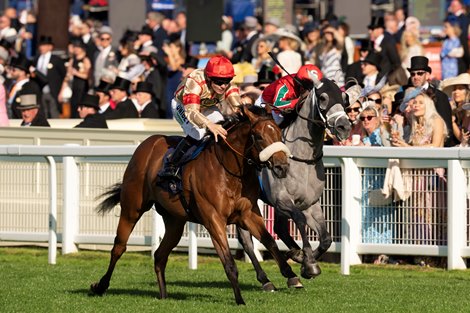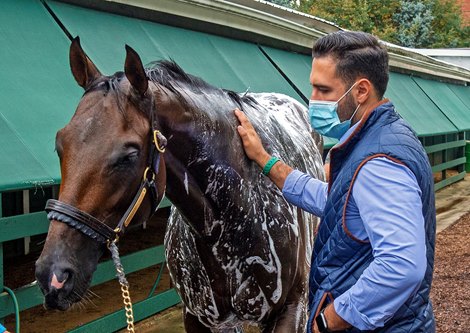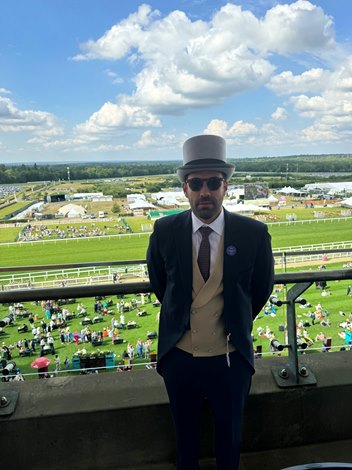Venezuelan trainer Jose D’Angelo has enjoyed a meteoric rise to success since first establishing his stable in the U.S. in 2019. In only five years, the 33-year-old has competed in some of the world’s biggest races on the finest stages—the Preakness Stakes (G1), the Breeders’ Cup World Championships, the Dubai World Cup (G1), and now his latest adventure—Royal Ascot. This year, D’Angelo became the only U.S.-based trainer to hit the board at the prestigious Royal meeting when his $9,000 colt Gabaldon finished a gallant second in the Windsor Castle Stakes. Owned by Soldi Stables, the 2-year-old had qualified for a start in the Ascot starting gate following a sharp debut score in the $100,000 Royal Palm Juvenile Stakes at Gulfstream Park.
D’Angelo spoke with BloodHorse about his time over at Royal Ascot and his gut-wrenching defeat with Gabaldon, adapting to the sales and racing in North America, and reflecting on the horse who first put his name on the national radar four years ago: Jesus’ Team .
BloodHorse: Can you talk about your experience at Royal Ascot? Was it like you expected?
Jose D’Angelo: It was amazing. When (Gabaldon) won the Royal Palm Juvenile Stakes I thought it was the perfect time to go over there. As soon as we qualified to go over from Gulfstream I called George Weaver (who had run 2023 Royal Palm Juvenile Stakes winner No Nay Mets at Royal Ascot). I have to thank him—he explained to me the process and events involved (with going to Ascot) and also Fergus Galvin. He helped me choose the right race for Gabaldon. At Ascot, you have so many races run that are very similar as opposed to over here, so that was new. He was a big help. Both (Weaver and Galvin) pointed me in the right direction.
BH: What are some of the differences in training and racing at Royal Ascot as opposed to the U.S.?
JD: You have so many different places to train the horse over there while over here we just have the one track. In England, you have fields, synthetic tracks, and gallop lanes. You have to be confident in your horse’s fitness as a trainer.
One of the most important things I learned over there was that you have to know and understand the track. The course is very hilly. It starts off downhill but the (second from last furlong) goes uphill and then the last furlong goes down again. It’s hard for the riders to judge.
Everyone said to me I had to walk the track with (jockey Emisael) Jaramillo. We ended up walking the track with (jockey) Oisin Murphy and he explained to us what to do and to notice where the dips are in the course.
Gabaldon training in the UK before the Windsor Castle Stakes
BH: You’ve already won graded stakes races here in the U.S. but what it mean for you and your team to take a horse over to Royal Ascot and perform the way he did?
JD: It was important to us. To go overseas with a horse, especially a 2-year-old is difficult. Me and my team have gone to Dubai before but we left with an older horse from Florida. But in Gabaldon’s case, we had to go to Churchill Downs, train one day there, and then leave the next day from Indiana, and then to England. The horse has a lot of class and he handled the trip.
In the past few days since coming home, I’ve watched the races on TV and you see everyone there all dressed up and it’s crazy to think we almost won there. We’ll win next time.
BH: Were you expecting that type of performance from Gabaldon?
JD: I was very confident in him. I told the owners the morning of the race ‘Hey don’t worry about us today they’re going to see us in front the whole way. The won’t touch us.’
You know he’s so fast. In training for this race I knew I was going to lose one breeze so I focused on training him to break very fast from the gate. I brought him to the gate so many times here (in Florida). And his workouts were always designed to give him more speed. It worked for him and he ran huge.
BH: What’s next for Gabaldon going forward?
JD: Probably pointing toward the Breeders’ Cup (Juvenile Turf Sprint, G1T). But the trip was a big stress on the horse. He was there less than a week between arriving, training, racing, and then he left the day after the race. He’s going to a farm to rest and he’ll tell us when he’s ready to come back.

Gabaldon (gray horse) finishes second to Ain’t Nobody in the Windsor Castle Stakes at Ascot Racecourse
BH: Can you talk about your relationship with his owner, Soldi Stables?
JD: We have a good relationship. Alfonso Soued and Eli Soldi. They’ve supported me for a number of years. They took a risk going over there with a 2-year-old. If you lose over there and run no good you can lose some better opportunities over here worth better money. But I thank them both for supporting me and believing in me. We went over there with a horse we paid $9,000 for with no big pedigree and never lost confidence in us.
BH: You’ve been very good at winning stakes races with low-priced horses. Jesus’ Team ran for a $25,000 claiming tag when you first got him, No More Time won Sam F. Davis Stakes (G3) and he cost $40,000, and now Gabaldon.
JD: When they run they run, they don’t know how much you paid for them. You just have to try to understand them and they’re going to try to give the best that they have.
BH: What do you typically look for when purchasing horses at the sales?
JD: I arrived in the U.S. at 2019. It’s a lot different buying horses here than in Venezuela. In Venezuela, you have to try to buy a bigger, stronger type of horse. There’s so, so many horses at the sales here and when I first got here I felt very lost. In 2020 I met Kenny McPeek. I told him ‘Hey Kenny I would like to learn from you, you always have nice horses’. He let me shadow him at two sales and give me some advice and then the next year I did the same with Donato Lanni and Bob Baffert. I learned a lot with them.
When I go to a sale, I try to apply that knowledge that I learned and I feel like it’s been working so far.
BH: Did you grow up with horses in Venezuela?
JD: I grew up in a barn. My father was a trainer in Venezuela. He came to the USA in 2015. In 2012 I got my license and started training myself in Venezuela. I did very well. I won the Eclipse over there for leading apprentice trainer. I won the big race meet over there.
I moved to the U.S. in 2019 just looking for better opportunities. Our second year we went to the Preakness, our third year we went to Dubai and now we’ve gone to Royal Ascot. I’m so happy with my decision to come here.
BH: What goals did you have for yourself when you came to the U.S. to start training?
JD: It was tough at first. In Venezuela, I used to train 150 horses and when I came here I had to start out from the bottom. Nobody knew me here and there weren’t many Venezuelan owners here either. I just woke up every day happy to go to the barn. I had to start with a lot of claiming horses. I respect claiming horses though, they teach you a lot. My goal was always to go to the top level and the big races. I grew up dreaming of competing in races like the Kentucky Derby and Breeders’ Cup and now it’s starting to happen for me.
I have around 90 horses now between Monmouth Park and South Florida (Palm Meadows Training Center and Gulfstream)
And next week New York. We’re sending a string to Saratoga for the meet. Saratoga has always been good to me every year I’ve gone there I’ve won. This year I’m going to have more horses there.
BH: What do you like about training and racing horses in South Florida?
JD: My father was training horses here and as soon as I arrived I came to his barn and now we work together. We’re a good team. That’s allowed me to travel to New Jersey and New York because I have him. He was a champion trainer in Venezuela, I learned everything from him.

Jose D’Angeo with Jesus’ Team before the 2020 Preakness Stakes at Pimlico Race Course
BH: You took Jesus’ Team from a $25,000 claimer to a multiple grade 1-placed earner of $1.3 million. What can you say reflecting on your experience with that horse?
JD: That horse put me on the map. His owner (Grupo 7C Stabe) too. I started working the horse at Palm Meadows and I remember seeing Tiz the Law train down there. I was winning races-though mostly claiming races. I’m competitive with myself and you have to be there (at the big races). (Jesus’ Team) was working great with big gallop outs and I told my father ‘We’re going to the Derby with this horse’. So we made a plan. With COVID-19 all the dates for the Triple Crown races were different. We ran in the Haskell and Pegasus at Monmouth and the horse qualified into the Derby. We ended up just going to the Preakness and I think that was the right decision. The horse showed up—he ran third in the Preakness and second in the Pegasus.



)






